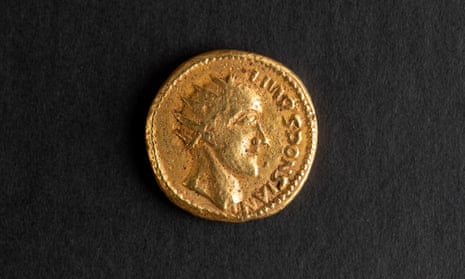(Dacia, in red, from wikipedia)
In 1713, four gold coins, seemingly from the time of the Roman Empire, were discovered in Transylvania, now Romania, and, from 106 AD to the 270s AD, the Roman province of Dacia. In the 19th century the coins were declared to be forgeries and mostly forgotten since then. Very recently, scientists at University College London have reexamined the coins, using ultraviolet imaging, visible light, and scanning electron microscopy, and concluded they are from the 3rd century, as reported in this article from The Guardian.
Two of the coins carry images of known Roman emperors, but a third has an image of what the scientists believe is a man named Sponsian (aka Sponsianus). The study authors speculate that Sponsian was a local Roman commander, who during the crisis of the 260s, when Dacia may have been isolated from the rest of the empire, took control of the province and its garrison and began minting coins (Dacia was known for its gold mines).
(Sponsian coin from The Guardian)

I expect this to be a controversial conclusion and will follow it as various scholars and scientists weigh in. The Guardian quotes one skeptic at the end of its article:
“They’ve gone full fantasy,” said Richard Abdy, the curator of Roman and iron age coins at the British Museum. “It’s circular evidence. They’re saying because of the coin there’s the person, and the person therefore must have made the coin.”
How is it even possible that someone named Sponsian, could have ruled a portion of the Roman Empire, yet leaving no historical record other than on a coin, which was thought to be a forgery? It's a combination of two factors.
First is the Crisis of the Third Century, or more specifically, the period between 235 and 284, when Rome had a minimum of 21 emperors, a number that doubles if all pretenders, claimants, and leaders of breakaway provinces are counted (in contrast, the empire saw only 26 emperors in its first 262 years). Political turmoil, economic disruption, plagues, barbarian raids across the Rhine and Danube, and the new Sassinid Empire in Persia all contributed to the confusion and instability. Stability was only restored when Diocletian became emperor in 284, but his restoration involved refounding the empire on a more centralized and bureaucratic basis, with increased taxation and a larger army, and with the Roman Senate finally completely disabled and removed from power. For more, read Diocletian Has A Very Good Day.
Second is the lack of surviving historical sources for the period. Roman history first comes into view with the works of Polybius, written in the third quarter of the second century BC, and then bursts into full daylight in the last decades of the Republic in the first century, with Caesar's Gallic Wars, the works and candid letters of Cicero, and other writers of the time. This continues into the early empire in the first century AD, with writers like Sallust, Livy, Tacitus, and Pliny the Elder, and Younger. They all had their perspectives and need to be read carefully but they were vivid writers who give us full pictures of many of the characters of that era. Historical writing and letters start to decline in the second century, and then in the third and fourth centuries were are left with little. There is Cassius Dio, writing probably in the 230s, the works of Ammianus Marcellinus, writing in the third quarter of the fourth century, whose early history of the empire has mostly disappeared, leaving us mostly with a brilliant account of events from 364 to 378, many of which Marcellinus witnessed. And we have the Historia Augusta, a purported history of the emperors, including those of the 3rd century, probably composed around 400, but which has at least at much fantasy as fact.
The result is that for the third century crisis we are left with a general outline with many details missing. We know, or think we know, the major events, but have little insight into details or of the characters of the emperors and generals of the time, unlike the personalities of the late Roman Republic who remain so vivid two thousand years later.
We know Dacia was troubled during this period. The province had been vulnerable since its creation, a salient on the far side of the Danube, exposed on three sides to barbarian incursions, and requiring a strong Roman garrison. As the threats grew across the empire, that garrison was weakened, leaving the province even more vulnerable to attack. We have a couple of brief mentions of barbarian attacks in those years and then, sometime between 271 and 275, the Emperor Aurelian withdrew the remaining garrison from the province, establishing a new border along the Danube. Beyond that, we know almost nothing. And the same is true for many other parts of the Empire.
Could Sponsian be real? Maybe. During this period there were many shadowy figures and events. A semi-independent Dacia, with a leader, supported by local communities, seeking protection from invasion is plausible. The breakaway Gaullic Empire of Postumus from 260 through 274, though on a larger scale, presented the same scenario, once repeated later in the century with the secession of Britain from 286 to 293 under Carausius. Even during the end of the empire in the west, we have the shadowy Roman state in Northern France, governed by Syragius, of whom we know very little, other than it outlasted the last Roman emperor in the west, not falling until 486.
Added: After posting I came across this article just published in Antigone, a very good journal of classical history and thought. Though the author points out that we only recently became aware of Domitian II, another usurper during the same time period, he believes it is absolutely clear that the Sponsian coins are forgeries. I have no idea who is correct but will definitely follow the story.
No comments:
Post a Comment